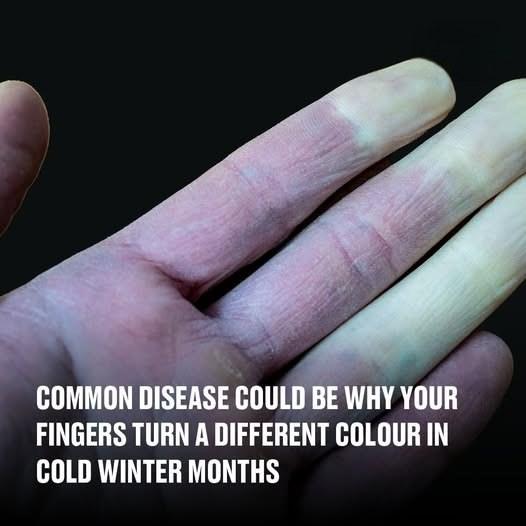As temperatures drop during the winter months, it’s common to experience cold hands and feet. But if you’ve ever noticed your fingers or toes dramatically changing color—turning pale white, bluish-purple, or even deep red—you might have been startled the first time it happened. Over time, many people dismiss it as a quirk of their body and simply accept it as a normal reaction to cold weather. However, these color changes could be a sign of an underlying condition known as Raynaud’s disease, also referred to as Raynaud’s phenomenon. While it’s not typically life-threatening, it can cause significant discomfort and, in some cases, indicate a deeper health issue that requires medical attention.

So, what exactly is Raynaud’s disease? Raynaud’s is a condition that affects blood circulation, particularly in the fingers and toes, but it can also impact other extremities like the nose, lips, ears, and even nipples. The condition occurs when blood vessels in these areas overreact to cold temperatures or stress, causing them to constrict excessively. This constriction reduces blood flow, leading to noticeable changes in skin color and temperature. Instead of just feeling cold, people with Raynaud’s often see their fingers turn white as blood drains away, then blue due to a lack of oxygen, and finally red as blood flow returns. These color changes can happen in stages or all at once and are often accompanied by pain, numbness, or a tingling sensation.
Dr. Melisa Lai Becker, in an interview with Good Morning America, explains, “For most people, chilly weather might make their fingers cold, but with Raynaud’s, the hands can turn ice-cold and visibly change color.” While the condition is fairly common and usually doesn’t lead to serious complications, it can still cause discomfort and interfere with daily activities.
What are the symptoms of Raynaud’s disease? The most obvious symptom is the dramatic color change in the fingers or toes. Typically, the skin turns white first, then blue, and finally red as blood flow is restricted and then restored. Alongside the color shifts, people with Raynaud’s often experience pain, numbness, or a pins-and-needles sensation in the affected areas. These symptoms usually appear when exposed to cold temperatures or during periods of stress or anxiety. In some cases, the condition can also affect less common areas like the ears, lips, nose, or nipples, causing similar sensations and discomfort.
These episodes can last anywhere from a few minutes to an hour, depending on how quickly blood flow returns to the affected area. After an episode, the skin may feel swollen or unusually sensitive. For most people, symptoms are mild and manageable, but in severe cases, prolonged restricted blood flow can lead to skin ulcers or, in rare instances, tissue damage.
When should you see a doctor? While Raynaud’s is often seen as a harmless condition, it’s important to consult a healthcare professional if the symptoms are severe, frequent, or if they start to interfere with your daily life. Dr. Lai Becker advises seeking medical advice if your symptoms persist for extended periods, cause intense pain, or make routine tasks—like buttoning your shirt or typing—difficult. In some instances, Raynaud’s can be a sign of an underlying health issue, such as lupus, rheumatoid arthritis, or scleroderma. Additionally, certain medications, including beta-blockers, migraine drugs, and chemotherapy agents, can trigger Raynaud-like symptoms.
Research indicates that Raynaud’s disease is more common in women, and symptoms often start to appear during the teenage years or early adulthood. Studies estimate that up to 20% of adults worldwide may experience some form of Raynaud’s. While the condition itself isn’t life-threatening, persistent or severe symptoms shouldn’t be ignored, as they can indicate a secondary health condition requiring treatment.
Managing Raynaud’s disease often involves lifestyle adjustments to prevent or minimize flare-ups. Keeping warm is one of the most effective strategies—wear insulated gloves, thick socks, and multiple layers when heading out in cold weather. Hand warmers can also offer temporary relief during sudden episodes. Indoors, try to avoid rapid temperature changes, and keep your home comfortably warm. Reducing emotional stress is equally important, as anxiety and tension can trigger Raynaud’s episodes. Techniques like meditation, deep breathing exercises, and yoga can help lower stress levels and prevent sudden flare-ups.
In more severe cases, medications might be necessary to improve blood flow. Doctors often prescribe calcium channel blockers, which relax blood vessels and help maintain proper circulation. For individuals with secondary Raynaud’s linked to an autoimmune disorder, treating the underlying condition is crucial for managing symptoms effectively.
If Raynaud’s disease affects your daily life or if symptoms worsen over time, don’t hesitate to seek medical help. A healthcare provider can offer a proper diagnosis, determine whether the condition is primary or secondary, and suggest a tailored treatment plan.
In conclusion, Raynaud’s disease is more common than most people realize, and while it’s usually manageable, it can still be disruptive and uncomfortable. The condition often goes unnoticed or is dismissed as a minor inconvenience, but recognizing its symptoms and understanding its triggers are key to managing it effectively. By keeping warm, managing stress, and consulting a healthcare professional when needed, people with Raynaud’s can significantly reduce flare-ups and maintain a comfortable lifestyle—even in the coldest months.
If you notice your fingers or toes turning pale, blue, or red regularly in response to cold or stress, don’t ignore it. Your body might be trying to tell you something important, and early intervention is the best step toward effective management and long-term comfort.





